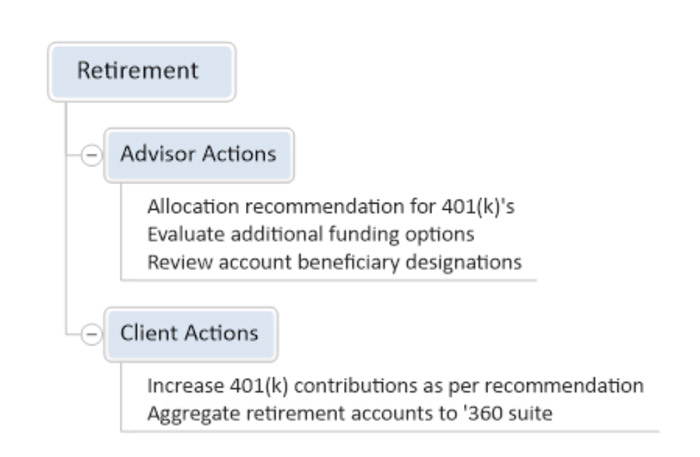Does Your Financial Plan Fit on 1 Page? It Should. Here's How.
Software planning tools can be handy, but they can also be complex and end up steering you in the wrong direction. What may work better? A little face time with your planner, leading to a simple, easy-to-follow financial "map."


Have you found your financial plan has fallen short of providing you the clarity and confidence you were hoping for? If so, your feelings may be due in part to how your plan was built. Maybe the plan is too complex … or just too impersonal. There’s a solution for this, and it’s definitely not high-tech. It’s a good, old-fashioned conversation.
Many financial advisers use software tools to build their plans. The crux of a software-based financial plan is the information that has been input. Most financial planning programs typically offer a generous range for inflation, rate of return, mortality age, percentage of current income needed at retirement and the probability (%) of achieving your financial goals as some examples.
Once your financials are entered and these inputs are selected, the software generates a plethora of modules that can be included in your plan. You and your adviser will then typically meet and discuss your current situation in comparison to your ideal. As the client, you’re probably excited to see these projections — “Can I buy that dream house in five years?”
From just $107.88 $24.99 for Kiplinger Personal Finance
Become a smarter, better informed investor. Subscribe from just $107.88 $24.99, plus get up to 4 Special Issues

Sign up for Kiplinger’s Free Newsletters
Profit and prosper with the best of expert advice on investing, taxes, retirement, personal finance and more - straight to your e-mail.
Profit and prosper with the best of expert advice - straight to your e-mail.
This is where the adviser-client conversation can become challenging. For example, if the plan “paints” an optimistic picture of your future, this could provide a false sense of security. If you request that your adviser lower the rate of return used, increase inflation and extend your mortality age by five years — wham — your plan now paints a totally different picture just by the click of a few buttons on a keyboard.
Sure, there will be those plans that still “paint” optimism even with very conservative inputs, but that’s not necessarily the norm.
A Nice, Long Talk Will Take You Far
As the co-founder of an advisory firm in Upstate New York, we feel planning is more art than science. We have found that intimate conversations centered around what is most important to clients about their money often yields invaluable answers that can serve as raw material for creating financial solutions for them.
Everyone has different plans or ideas for using their money. When you and your adviser are both clear as to yours, you can together begin building a “map” of sorts, which can provide clarity and direction for your financial life. Complexity isn’t a prerequisite for sound planning.
You can often share more about what you are trying to do or accomplish in 60 minutes of quality conversation with your adviser than through a 10-page data-intake form.
To this end, my business partner, Dennis Coughlin, and I have both have had experiences where our recommendations were vastly different for clients who had very similar personal and financial demographics. This happens as a result of knowing specifically what is trying to be accomplished.
2 Seemingly Similar Clients End Up with Very Different Plans
For example, I recently met with two couples who have very similar income levels and assets. They are also close in age. So the data entered into the typical software planning program would certainly look similar. The primary difference between them is something a software program would have a harder time picking up on: their lifestyle aspirations.
Couple No. 1 want to spend time with family, enjoy their home, travel twice per year and enjoy their community. Couple No. 2 want to spend eight months per year in Florida, gift annually to their kids and join the most expensive golf club in their hometown when home during the summer months.
As you may have guessed, Couple No. 1 can expect to retire earlier than Couple No. 2.
Anatomy of a Plan
So, while software has its place in financial planning, I prefer a more personal approach. After discussions with clients, my partner and I draw up a simplified financial planning map for them. It comes with plenty of room for notes, action items and tweaks over time. Here’s an example of what the basic framework of one client’s map might look like:

The map outlines some common areas we typically explore with clients. Depending on the scope of work, there might be five to 10 actionable items for each financial area. The lifestyle component is dynamic and typically includes many of the personal areas most important to each client (these often change from client to client).
If I use the retirement branch of the map as an example, here is an abbreviated version of what it might look like:

As time passes, adjustments are made where necessary to assure the map continues to provide good coordinates as to their desired financial destination. The financial climate changes, their health can change, their intentions can change too. The map focuses on what we can control rather than what we cannot.
Take the Next Step
If you find yourself feeling confused and overwhelmed as to where your retirement plan is headed, have a sincere conversation with your adviser about those feelings. Ask him or her to provide you a helicopter view of all the moving parts of your plan. This may help you get a better sense of clarity while reducing financial stress.
We’re living in a world where information comes at us from various directions at warp speeds. The concept of less being more can be appealing … in many areas of life.
Branch address: 139 Genesee St., New Hartford, NY. Securities and advisory services offered through Commonwealth Financial Network, Member FINRA/SIPC, a Registered Investment Adviser.
Profit and prosper with the best of Kiplinger's advice on investing, taxes, retirement, personal finance and much more. Delivered daily. Enter your email in the box and click Sign Me Up.

Chris Giambrone is a co-founder of CG Capital™, a boutique wealth management firm based in New Hartford, N.Y. He is a CERTIFIED FINANCIAL PLANNER™ and Accredited Investment Fiduciary® (AIF®). Chris has also earned a Certificate in Retirement Planning from the Wharton School of Finance at the University of Pennsylvania.
-
 Your Guide to Buying Art Online
Your Guide to Buying Art OnlineFrom virtual galleries to social media platforms, the internet offers plenty of places to shop for paintings, sculptures and other artwork without breaking the bank.
-
 Samsung Galaxy S25 Ultra for $4.99 a Month: A Closer Look at Verizon’s Deal
Samsung Galaxy S25 Ultra for $4.99 a Month: A Closer Look at Verizon’s DealVerizon’s aggressive pricing makes Samsung’s top-tier phone tempting, but the real cost depends on your plan and how long you stay.
-
 I'm 59 with $1.7 million saved and lost my job. Should I retire?
I'm 59 with $1.7 million saved and lost my job. Should I retire?We asked professional wealth planners for advice.
-
 A Wealth Adviser Explains: 4 Times I'd Give the Green Light for a Roth Conversion (and 4 Times I'd Say It's a No-Go)
A Wealth Adviser Explains: 4 Times I'd Give the Green Light for a Roth Conversion (and 4 Times I'd Say It's a No-Go)Roth conversions should never be done on a whim — they're a product of careful timing and long-term tax considerations. So how can you tell whether to go ahead?
-
 A 4-Step Anxiety-Reducing Retirement Road Map, From a Financial Adviser
A 4-Step Anxiety-Reducing Retirement Road Map, From a Financial AdviserThis helpful process covers everything from assessing your current finances and risks to implementing and managing your personalized retirement income plan.
-
 The $183,000 RMD Shock: Why Roth Conversions in Your 70s Can Be Risky
The $183,000 RMD Shock: Why Roth Conversions in Your 70s Can Be RiskyConverting retirement funds to a Roth is a smart strategy for many, but the older you are, the less time you have to recover the tax bite from the conversion.
-
 A Financial Pro Breaks Retirement Planning Into 5 Manageable Pieces
A Financial Pro Breaks Retirement Planning Into 5 Manageable PiecesThis retirement plan focuses on five key areas — income generation, tax management, asset withdrawals, planning for big expenses and health care, and legacy.
-
 4 Financial To-Dos to Finish 2025 Strong and Start 2026 on Solid Ground
4 Financial To-Dos to Finish 2025 Strong and Start 2026 on Solid GroundDon't overlook these important year-end check-ins. Missed opportunities and avoidable mistakes could end up costing you if you're not paying attention.
-
 Are You Putting Yourself Last? The Cost Could Be Your Retirement Security
Are You Putting Yourself Last? The Cost Could Be Your Retirement SecurityIf you're part of the sandwich generation, it's critical that you don't let the needs of your aging parents come at the expense of your future.
-
 I'm an Insurance Pro: It's Time to Prepare for Natural Disasters Like They Could Happen to You
I'm an Insurance Pro: It's Time to Prepare for Natural Disasters Like They Could Happen to YouYou can no longer have the mindset that "that won't happen here." Because it absolutely could. As we head into 2026, consider making a disaster plan.
-
 The Future of Philanthropy Is Female: How Women Will Lead a New Era in Charitable Giving
The Future of Philanthropy Is Female: How Women Will Lead a New Era in Charitable GivingWomen will soon be in charge of trillions in charitable capital, through divorce, inheritance and their own investments. Here's how to use your share for good.